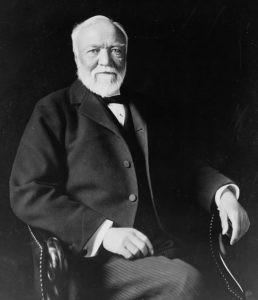Welcome to this article where we will be discussing one of the most famous American entrepreneurs of all time: Andrew Carnegie! During the late 19th centuries, several entrepreneurs became famous due to their wealth and influence on society. Carnegie was mostly famous due to his reputation for philanthropy.

Interesting Facts about Andrew Carnegie
1. He was born and raised in poverty.
Carnegie was born in the 25th of November, 1835 in Dunfermline, Scotland. The family was extremely poor. His father, William, was a hand-loom weaver and his mother, Margaret, repaired shoes. William refused to work in the local factories at the turn of the industrial revolution, which further devastated the family’s finances. Growing up, Carnegie was inspired by the commitment and hard work of his mother compared to his father, which she did in the name of providing a better future for her children. In fact, it was Margaret, who decided emigrated to America in 1848, due to the great famine that swept the land.
2. Andrew Carnegie was mostly self-taught and had a deep appreciation for learning.
Carnegie and his brother were denied the privilege of entering school due to their low class. All these experiences collectively helped Carnegie to understand the importance of equality. However, he still had a deep interest in learning and reading. During the family’s emigration to the United States via ship, he would go on to learning everything he could about the ship and its daily operations. He taught himself how to use the Morse code and was one of the few individual telegraphers who could translate the code instantly.
3. He had a strong love for libraries.
This Andrew Carnegie Fact is known to some people, while it is not known to many others. He had a deep appreciation for libraries. During his teen years, he was barred from entering the local library due to a new rule that declared that only patrons of the school could enter. He ended up writing a letter to the council and the newspapers, which resulted in opening all the libraries in Pittsburgh to the youth population. His love for libraries stretched on to his years of philanthropy where he established and funded for around 3000 public libraries in the United States.
4. His entrepreneurship started at a young age.
The first job that Carnegie did was a messenger and later as a telegrapher in 1849. He would go on to becoming a Secretary for a railroad executive, Thomas Scott, who would become his mentor. At the age of 20, William Carnegie passed away, leaving Andrew to become the breadwinner of the family. He began to invest in his earnings from his job. This started with an investment in Woodruff Sleeping Car Company. He would go onto creating a merger between Woodruff and the Pullman Car Company. He moved on to working in the railroad industry, working up to becoming a superintendent where he learned valuable skills in business and investing. These entrepreneurial skills would form the basis of the success of Carnegie’s eventual years as a business magnate.
5. Investing wisely was the key to becoming a successful industrialist.
Carnegie invested in an oil field in Pennsylvania in 1864. This earned him $1 million. He progressed to purchasing a steel mill and made business connections with powerful figures in the world of industry. The following year (1865), Carnegie established his first company, the Keystone Bridge Company, and channeled his effort into ironworks. Upon expanding his business, he was well on the way to fame and wealth.
6. Andrew Carnegie focused on building the country’s infrastructure via the steel industry.
It became clear that Carnegie had the instincts and aptitudes for innovating and optimizing his business. As an example, he successfully managed to incorporate the Bessemer process of steel production, which made the entire steel industry cost-effective. Carnegie’s steel corporations helped to build the country’s wide network of skyscrapers, bridges, railroads, and ships. Within a short period of time, his steel industry had occupied a large percentage of the global steel market. By the late 1880s, steel production in the US had overtaken that of the UK. In 1901, his business deal with a banker, J.P. Morgan, led to the formation of the U.S. Steel Corporation which became one of the largest businesses in the world.
7. He focused on philanthropic ventures during his final years.
Carnegie retired from business in 1901. With the large accumulation of wealth he had earned, he decided to focus his interests on giving back to the nation. As he had a lifelong appreciation of equality, social justice, and education, he established numerous foundations and related causes. This included the Carnegie Endowment for International Peace, Carnegie Institution of Science and the Carnegie-Mellon University. He further established the Carnegie Dunfermline Trust to enrich the lives of the population of his birth town. Carnegie passed away on the 11th of August, 1919 in his estate in Massachusetts and he was buried in Sleepy Hollow, New York. His remaining wealth was given for charity purposes and the legacy he created continues to prevail to this very day.
I hope that from reading these Andrew Carnegie facts, you learned something out of it! For more information,visit historical people facts.
